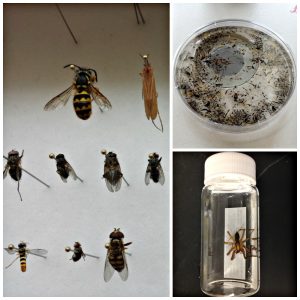 The results are in for the Fall 2014 School Malaise Trap Program and they are truly remarkable! This Fall marked the first nationwide offering of the program, with students from across Canada exploring the biodiversity in their schoolyards and discovering how we can use DNA barcoding to inventory life on our planet. In all, 2,479 students from 92 classrooms, 59 schools, 46 cities, and 6 provinces and territories participated in the program. The 59 Malaise traps collected specimens from September 22 to October 3.
The results are in for the Fall 2014 School Malaise Trap Program and they are truly remarkable! This Fall marked the first nationwide offering of the program, with students from across Canada exploring the biodiversity in their schoolyards and discovering how we can use DNA barcoding to inventory life on our planet. In all, 2,479 students from 92 classrooms, 59 schools, 46 cities, and 6 provinces and territories participated in the program. The 59 Malaise traps collected specimens from September 22 to October 3.
The 59 traps on average collected 1,034 specimens for the collecting period. Our staff sorted 61,052 specimens and 13,846 of these primarily insect specimens were barcoded. The DNA barcodes allowed us to determine that 3,402 species were collected over the two week period of the program, more than twice as many as any of our previous School Malaise Trap Programs! We are excited to report that 324 of these species were brand new to our DNA barcode library (BOLD), representing a significant contribution to the International Barcode of Life project.
To view the full results of the program, including an overall detailed program report, full species list, and full image library, please click here. You can also access our “winners” ranking sheets here.
 Not only were your collection numbers astounding, your species discoveries were even more exciting! Over the next few weeks the SMTP team will be highlighting your discoveries through our blog posts and we hope that you will do the same! First off, let’s get a sense of what you collected in your Malaise trap.
Not only were your collection numbers astounding, your species discoveries were even more exciting! Over the next few weeks the SMTP team will be highlighting your discoveries through our blog posts and we hope that you will do the same! First off, let’s get a sense of what you collected in your Malaise trap.
Most of the 3,402 species that you collected were arthropods — invertebrates with a hard external skeleton. If you look at the pie chart below, you’ll notice that many (36%) of the species were flies (scientific name: Diptera). Some groups of flies were particularly diverse; there were 285 species of midges (Chironomidae), 116 species of fungus gnats (Sciaridae), and 95 species of scuttle flies (Phoridae). In addition, just like Fall 2013 and Spring 2014 programs, the most abundant species was a midge. After flies, the next most species diverse group was bees, wasps, and ants (Hymenoptera), followed by the true bugs (Hemiptera). Most of the species in these groups have wings, so it’s not surprising that they were collected in your Malaise traps. However, you also collected some groups that don’t fly such as springtails (Collembola), spiders (Araneae), and snails (Stylommatophora).

Stay tuned for our Fall 2014 interesting species discoveries!





 The results are in for the Fall 2014 School Malaise Trap Program and they are truly remarkable! This Fall marked the first nationwide offering of the program, with students from across Canada exploring the biodiversity in their schoolyards and discovering how we can use
The results are in for the Fall 2014 School Malaise Trap Program and they are truly remarkable! This Fall marked the first nationwide offering of the program, with students from across Canada exploring the biodiversity in their schoolyards and discovering how we can use 